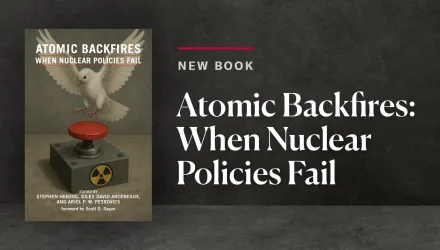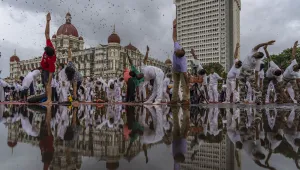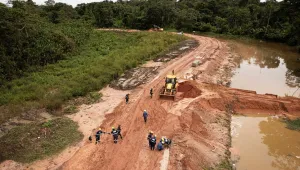In celebration of the 70th anniversary of victory over Nazi Germany and on the eve of the anniversary of the meeting of Soviet and American troops on the Elbe, the Carnegie Moscow Center organized a conference held April 23, 2015 in Moscow to discuss the experience of Russian-American alliance during the Second World War, as well as the experience of cooperation and rivalry after the end of the Cold War. The Elbe meeting took place on April 25, 1945.
Brigadier General (ret.) Kevin Ryan, director of the Belfer Center's Defense and Intelligence Projects and founder of The Elbe Group, spoke at the conference about the significance of the Elbe anniversary to U.S.-Russian relations today. He delivered his comments in Russian. Following is the English translation of his remarks.
There is an iconic photo from the meeting on the Elbe. It is a picture of American Lieutenant William Robertson and Soviet Lieutenant Alexander Silvashko with their arms around each other, smiling, in front of their national flags. The picture of Robertson and Silvashko was taken on April 26th, the day after the meeting. It is a picture that has come to symbolize the meeting on the Elbe. But that picture is not my favorite picture of the meeting on the Elbe.
My favorite picture is one taken by American Private Paul Staub on 25 April – a picture of the meeting as it was actually happening. In Staub’s photo we see that when the American and Soviet patrols got to Torgau they found the bridge over the Elbe destroyed. The bridge was a twisted mass of steel, half submerged in the Elbe River, which was swollen with spring rains. Staub took the picture as LT Bill Robertson and Sergeant Frank Huff climbed out on the broken bridge to meet Sergeant Nikolai Andreev over the middle of the river. It was a risky thing for all of them to do. They could have easily slipped and fallen into the river and drowned.
LT Robertson and his three soldiers were not even supposed to be in Torgau that day. They had been assigned to go look for prisoners of war and make sure they got back to safety. In fact, Robertson had been ordered not to go the Elbe River. He was supposed to go no further than a few kilometers from his headquarters – no where near Torgau. But Robertson was what we in the US Army call a “cowboy:” someone who wanted to be where the action was. There were two other patrols that day who also met with Russian soldiers along the Elbe. But Robertson’s patrol got its report back to headquarters first.
When Robertson’s Division Commander, General Rheinhardt, heard that Robertson had gone to the Elbe River, he decided to court martial him. But the Army Commander, General Bradley, was pleased with the link up and General Rheinhardt changed his mind. Making the link up with the Soviet forces was very risky for Robertson and his men. First, LT Silvashko and his men thought the Americans might be Germans, so they fired at them from across the river. Robertson was almost shot. Eventually Robertson found a Russian-speaking prisoner in the town who helped signal to Silvashko that they were Americans. Then they had to climb out on the damaged bridge. But those brave men, Americans and Russians, made the effort and linked up.
For the next 70 years, the US-Russian relationship has been like that day in Torgau: sometimes shooting at each other, sometimes taking the risk to climb out on a broken bridge and link up.
That is what the Elbe Group does today – try to keep communications open between the US and Russia even when the bridges between us are damaged. The Elbe Group consists of retired US and Russian generals from the military and intelligence services. Our purpose is to maintain an open channel of communication between our two sides and to discuss the most sensitive issues between us. It is not our purpose to always agree and, we often do not agree. Our meetings are not secret. We meet in third countries because some of us cannot get visas to each other’s country. So we have met in places like Istanbul, Morocco, and Portugal. This past March we met in Torgau Germany.
We speak openly and frankly and respectfully to each other. It is a respect that has been built up over 5 years of meetings. At our meeting in Torgau we discussed Ukraine and Crimea. We also discussed NATO operations in the Baltic States and Eastern Europe. We talked about common threats to the US and Russia, such as extremism and cyber and nuclear terrorism.
Regarding nuclear terrorism and extremism, both sides agreed that the US and Russia need to work together to combat these threats. We also agreed that the threat from cyber terrorism and cyber criminals is a rapidly growing problem that requires a joint international response.
But regarding Ukraine and Crimea, we did not agree on much. The Russian side insisted that Russia was right in annexing Crimea and is right in supporting the Russian speaking separatists in Ukraine. The Russian side believes that the US is behind the instability in Ukraine and the Middle East and hopes to remain the world’s sole super power by creating crises around the world.
Regarding NATO in Eastern Europe, the US side invited the commander of NATO Ground Forces, LTG Nicholson, to brief the US and Russian sides on what NATO is doing. His briefing, however, did not convince the Russians that NATO actions are not a threat. They still believe that NATO troop and missile defense deployments in the Baltic States and Eastern Europe are a threat to Russian security.
The Americans of course had a completely different view of these situations. The US side insisted that Russia illegally invaded and took Crimea from Ukraine. The US side believes that Russian support to separatists in Ukraine is the reason the country is in crisis – not because of US actions. The US side was amazed that their Russian colleagues thought that America had orchestrated the Arab Spring, since the Americans themselves were just as surprised by what happened there. With regard to NATO, the Americans were adamant in their commitment to protect the Baltic States against any threat similar to what has happened in Ukraine.
What the two sides did agree on was that the risk of an accident along the Baltic border has become significant. As military men, we recognized that having so many aircraft, warships, and troops in the region will eventually lead to an accident – some clash of forces or shoot down of an airplane or ramming of a ship. To prevent such an accident from escalating into combat, we recommended that our defense leaders create a channel of communication for operational commanders to quickly talk and establish the facts of any accident between our forces.
Seventy years ago, our fathers and grandfathers fought together against a common enemy. That war killed millions and destroyed nations. Russia knows the cost better than most having lost over 27 million people, more than any other nation. In the wartime poem, "Vasiliy Terkin," the hero, Terkin, tried to explain to his comrades how terrible war can be. Terkin asked, “Что такое сабантуй? Сабантуй бывает разный.” ("What is a Sabantuy? Sabantuy's are all different.") Terkin, I think, would say that what has happened in Crimea – “Это малый сабантуй.” ("That's a small Sabantuy.") About Ukraine he would probably say – “Это средний сабантуй.” ("That's a medium Sabantuy.") But about what could happen in the Baltics and elsewhere in Europe – “Это главный сабантуй.” ("That's a major Sabantuy.")
Today we not only need brave lads like Terkin who are ready to defend our nations, but we also need brave leaders who will climb out on broken bridges in order to avoid shooting at each other. I know that the lads exist. I hope that the leaders do too.



